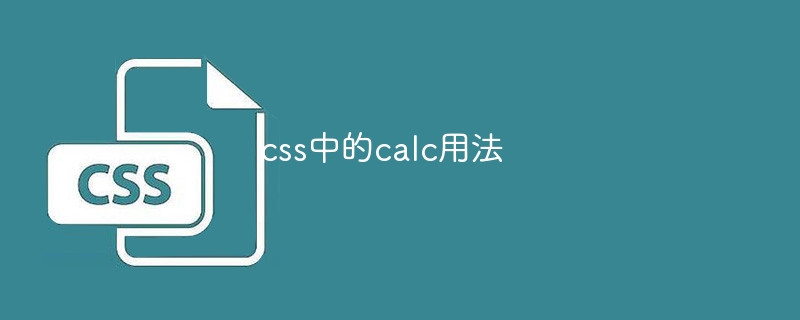calc usage in css
The Calc function in CSS allows developers to perform mathematical operations. Usage steps: define variables, create expressions containing the required operations, and apply the expressions to styles. Advantages include flexibility, elimination of dependency on JavaScript, and dynamic value calculations. The Calc function is widely supported by all modern browsers.

Calc Usage in CSS
The Calc function in CSS is a powerful tool that allows development Or perform mathematical operations in CSS stylesheets. It can perform basic arithmetic operations such as addition, subtraction, multiplication and division.
Syntax:
1 |
|
Where, expression can contain numbers, units, percentages and other Calc function calls.
Usage:
When using the Calc function, you need to follow the following steps:
-
Define variables: If you want to reuse values, you can use CSS variables to store them. For example:
1
<code>--margin: 10px;</code>Copy after login -
Create an expression: In the Calc function, create an expression that contains the required operation. For example:
1
<code>calc( 10px + 5px )</code>Copy after login -
Apply to style: Apply a Calc expression to a CSS rule. For example, to set the margin of an element to 15px, you would use the following style:
1
<code>margin: calc(var(--margin) + 5px );</code>Copy after login
Example:
-
Change element size:
1
<code>width: calc(50% - 10px);/* 将元素宽度设置为屏幕宽度的 50%,减去 10px */</code>Copy after login -
Create dynamic spacing:
1
<code>margin: calc(10px + 10%);/* 根据父元素大小动态设置边距 */</code>Copy after login -
Calculate font Size:
1
<code>font-size: calc(1.2rem + 2px);/* 根据基准字体大小动态计算字体大小 */</code>Copy after login
Advantages:
- Allows mathematical operations in CSS, increasing flexibility.
- Eliminates dependence on JavaScript and simplifies code.
- Provides the ability to dynamically calculate values to make the layout more responsive.
Browser Support:
The Calc function is widely supported by all modern browsers, including Chrome, Firefox, Safari, and Edge.
The above is the detailed content of calc usage in css. For more information, please follow other related articles on the PHP Chinese website!

Hot AI Tools

Undresser.AI Undress
AI-powered app for creating realistic nude photos

AI Clothes Remover
Online AI tool for removing clothes from photos.

Undress AI Tool
Undress images for free

Clothoff.io
AI clothes remover

Video Face Swap
Swap faces in any video effortlessly with our completely free AI face swap tool!

Hot Article

Hot Tools

Notepad++7.3.1
Easy-to-use and free code editor

SublimeText3 Chinese version
Chinese version, very easy to use

Zend Studio 13.0.1
Powerful PHP integrated development environment

Dreamweaver CS6
Visual web development tools

SublimeText3 Mac version
God-level code editing software (SublimeText3)

Hot Topics
 1667
1667
 14
14
 1426
1426
 52
52
 1328
1328
 25
25
 1273
1273
 29
29
 1255
1255
 24
24
 How to use bootstrap in vue
Apr 07, 2025 pm 11:33 PM
How to use bootstrap in vue
Apr 07, 2025 pm 11:33 PM
Using Bootstrap in Vue.js is divided into five steps: Install Bootstrap. Import Bootstrap in main.js. Use the Bootstrap component directly in the template. Optional: Custom style. Optional: Use plug-ins.
 Understanding HTML, CSS, and JavaScript: A Beginner's Guide
Apr 12, 2025 am 12:02 AM
Understanding HTML, CSS, and JavaScript: A Beginner's Guide
Apr 12, 2025 am 12:02 AM
WebdevelopmentreliesonHTML,CSS,andJavaScript:1)HTMLstructurescontent,2)CSSstylesit,and3)JavaScriptaddsinteractivity,formingthebasisofmodernwebexperiences.
 The Roles of HTML, CSS, and JavaScript: Core Responsibilities
Apr 08, 2025 pm 07:05 PM
The Roles of HTML, CSS, and JavaScript: Core Responsibilities
Apr 08, 2025 pm 07:05 PM
HTML defines the web structure, CSS is responsible for style and layout, and JavaScript gives dynamic interaction. The three perform their duties in web development and jointly build a colorful website.
 How to write split lines on bootstrap
Apr 07, 2025 pm 03:12 PM
How to write split lines on bootstrap
Apr 07, 2025 pm 03:12 PM
There are two ways to create a Bootstrap split line: using the tag, which creates a horizontal split line. Use the CSS border property to create custom style split lines.
 How to insert pictures on bootstrap
Apr 07, 2025 pm 03:30 PM
How to insert pictures on bootstrap
Apr 07, 2025 pm 03:30 PM
There are several ways to insert images in Bootstrap: insert images directly, using the HTML img tag. With the Bootstrap image component, you can provide responsive images and more styles. Set the image size, use the img-fluid class to make the image adaptable. Set the border, using the img-bordered class. Set the rounded corners and use the img-rounded class. Set the shadow, use the shadow class. Resize and position the image, using CSS style. Using the background image, use the background-image CSS property.
 How to set up the framework for bootstrap
Apr 07, 2025 pm 03:27 PM
How to set up the framework for bootstrap
Apr 07, 2025 pm 03:27 PM
To set up the Bootstrap framework, you need to follow these steps: 1. Reference the Bootstrap file via CDN; 2. Download and host the file on your own server; 3. Include the Bootstrap file in HTML; 4. Compile Sass/Less as needed; 5. Import a custom file (optional). Once setup is complete, you can use Bootstrap's grid systems, components, and styles to create responsive websites and applications.
 How to resize bootstrap
Apr 07, 2025 pm 03:18 PM
How to resize bootstrap
Apr 07, 2025 pm 03:18 PM
To adjust the size of elements in Bootstrap, you can use the dimension class, which includes: adjusting width: .col-, .w-, .mw-adjust height: .h-, .min-h-, .max-h-
 How to use bootstrap button
Apr 07, 2025 pm 03:09 PM
How to use bootstrap button
Apr 07, 2025 pm 03:09 PM
How to use the Bootstrap button? Introduce Bootstrap CSS to create button elements and add Bootstrap button class to add button text




